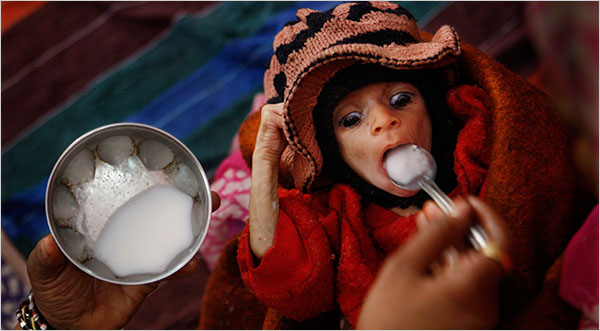Friday, March 13, 2009
Child malnutrition in India
"Small, sick, listless children have long been India’s scourge — “a national shame,” in the words of its prime minister, Manmohan Singh. But even after a decade of galloping economic growth, child malnutrition rates are worse here than in many sub-Saharan African countries, and they stand out as a paradox in a proud democracy.
China, that other Asian economic powerhouse, sharply reduced child malnutrition, and now just 7 percent of its children under 5 are underweight, a critical gauge of malnutrition. In India, by contrast, despite robust growth and good government intentions, the comparable number is 42.5 percent. Malnutrition makes children more prone to illness and stunts physical and intellectual growth for a lifetime."
One does indeed wonder why in the world this is so as India does run a very large feeding program for these kids. "The $1.3 billion Integrated Child Development Services program, India’s primary effort to combat malnutrition, finances a network of soup kitchens in urban slums and villages."
Unfortunately, most of these operating centers are not up to par and the report details further that either the people who it intends to benefit are not showing up or that the center themselves lack the resources to adequately measure the progress of the mother and the kids they are feeding.
"A World Food Program report last month noted that India remained home to more than a fourth of the world’s hungry, 230 million people in all. It also found anemia to be on the rise among rural women of childbearing age in eight states across India. Indian women are often the last to eat in their homes and often unlikely to eat well or rest during pregnancy. Ms. Menon’s institute, based in Washington, recently ranked India below two dozen sub-Saharan countries on its Global Hunger Index."
As the World Food Program has been rather successful in this area of feeding kids I am wondering why the government does not hand it over to them?
"Childhood anemia, a barometer of poor nutrition in a lactating mother’s breast milk, is three times higher in India than in China, according to a 2007 research paper from the institute.
The latest Global Hunger Index described hunger in Madhya Pradesh, a destitute state in central India, as “extremely alarming,” ranking the state somewhere between Chad and Ethiopia.
More surprising, though, it found that “serious” rates of hunger persisted across Indian states that had posted enviable rates of economic growth in recent years, including Maharashtra and Gujarat.
Here in the capital, which has the highest per-capita income in the country, 42.2 percent of children under 5 are stunted, or too short for their age, and 26 percent are underweight. A few blocks from the Indian Parliament, tiny, ill-fed children turn somersaults for spare change at traffic signals.
Back in Jahangirpuri, a dead rat lay in the courtyard in front of Ms. Bala’s nursery. The narrow lanes were lined with scum from the drains. Malaria and respiratory illness, which can be crippling for weak, undernourished children, were rampant. Neighborhood shops carried small bags of potato chips and soda, evidence that its residents were far from destitute.
In another alley, Ms. Menon met a young mother named Jannu, a migrant from the northern town of Lucknow. Jannu said she found it difficult to produce enough milk for the baby in her arms, around 6 months old. His green, watery waste dripped down his mother’s arms. He often has diarrhea, Jannu said, casually rinsing her arm with a tumbler of water.
Ms. Menon could not help but notice how small Jannu was, like so many of Jahangirpuri’s mothers. At 5 feet 2 inches tall, Ms. Menon towered over them. Children who were roughly the same age as her own daughter were easily a foot shorter. Stunted children are so prevalent here, she observed, it makes malnutrition invisible.
“I see a system failing,” Ms. Menon said. “It is doing something, but it is not solving the problem.”
Source
Labels:
Children,
Health,
International
Subscribe to:
Post Comments (Atom)

Horrifying indeed! I can't help but wonder if this doesn't have to do with the caste system in India and the low position of women, not to mention the fact that simple hygiene would help to prevent a plethora of illnesses.
ReplyDelete